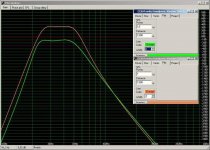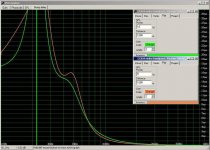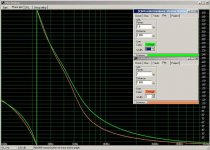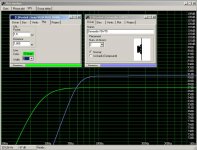I'm new to designing loudspeakers. I have another thread elsewhere on this site about rebuilding a pair of classic Tannoys. But since I've got my hands on a pair of cheap but excellent Dynaudio Audience 122's, that plan is put on hold for now. The tannoys are now the surround channels in my 5.1 setup. This thread is about the .1 - the subwoofer.
I've been working on a few ideas for a subwoofer. Initially, I wanted to go for a 8" or 10" vented design. But those didn't give me the bass extension I wanted, without becoming incredibly large. Frequency, phase and groupdelay plots were quite smooth. I've also experimented with two 6th order bandpass designs. Those give me useable bandwith (25Hz - 60Hz) at decent spl levels, especially with an 8" Visaton TIW200XS driver. However, Groupdelay and Phase plots go off the charts. I can't imagine that's good for perfomance. I'm not exactly sure what groupdelay means, so if someone could explain it in a nutshell, I'd be greatful. But I imagine a lower value means faster response and better articulation. My dynaudio's are pretty fast in the low end, so if the sub is to integrate well, it should be fast aswell. Right?
Please take a look at the pictures below. Comments are greatly appreciated. I'd like to know things like how do bandpass designs compare to vented designs. Things about performance in general, etc.
Thank you!!!
I've been working on a few ideas for a subwoofer. Initially, I wanted to go for a 8" or 10" vented design. But those didn't give me the bass extension I wanted, without becoming incredibly large. Frequency, phase and groupdelay plots were quite smooth. I've also experimented with two 6th order bandpass designs. Those give me useable bandwith (25Hz - 60Hz) at decent spl levels, especially with an 8" Visaton TIW200XS driver. However, Groupdelay and Phase plots go off the charts. I can't imagine that's good for perfomance. I'm not exactly sure what groupdelay means, so if someone could explain it in a nutshell, I'd be greatful. But I imagine a lower value means faster response and better articulation. My dynaudio's are pretty fast in the low end, so if the sub is to integrate well, it should be fast aswell. Right?
Please take a look at the pictures below. Comments are greatly appreciated. I'd like to know things like how do bandpass designs compare to vented designs. Things about performance in general, etc.
Thank you!!!
Attachments
Group-delay is the delay of the specific frequency with respect to the original, so longer delay is worse. Bear in mind that the plot you are looking at appears worse than it is because it is including the low-pass element of the system, which is often not modelled when looking at more traditional box designs.
Unless you are going for most bang per buck though I would look at a better larger driver in a sealed or reflex box and a bigger amp. Also be aware that if your only connection option is the LFE signal then a bandpass design is not suitable because the LFE signal is already filtered.
Unless you are going for most bang per buck though I would look at a better larger driver in a sealed or reflex box and a bigger amp. Also be aware that if your only connection option is the LFE signal then a bandpass design is not suitable because the LFE signal is already filtered.
Thanks.
I have two options for connection. A fullrange line-out, or one of two filtered dedicated sub pre-outs (NAD T752). To be honest, the 8" design I posted here is still a bit too large for what I had in mind. I would like someting similar to the Dynaudio Sub 300. But that is veeeeerrryyyy expensive... I'm sure it'll integrate neatly, because is's a Dynaudio too. But building it yourself if much more fun.
I've never managed to get a small vented or closed box simulation of reasonable dimensions with an 8" or 10" driver to be (almost) linear below 40Hz. They roll off pretty fast and have a large boost at the resonant frequency, even more so, when that frequency is below the resonant frequency of the driver (fs?). At that point box volume skyrockets. The factory subs mitgh be doing something with filtering the input signal, I guess.
The sub I'm looking for needs only play below 60Hz, probably 50, since the front-, center and rear channels are all capable of playing down to 45 Hz effortlessly. But below that, there's almost nothing. I need the sub to perform equally well with music and HT.
So, What are my options? You think a small closed or vented box will do the job? Play down to below 30Hz, when it's well designed?
Thanks.
I have two options for connection. A fullrange line-out, or one of two filtered dedicated sub pre-outs (NAD T752). To be honest, the 8" design I posted here is still a bit too large for what I had in mind. I would like someting similar to the Dynaudio Sub 300. But that is veeeeerrryyyy expensive... I'm sure it'll integrate neatly, because is's a Dynaudio too. But building it yourself if much more fun.
I've never managed to get a small vented or closed box simulation of reasonable dimensions with an 8" or 10" driver to be (almost) linear below 40Hz. They roll off pretty fast and have a large boost at the resonant frequency, even more so, when that frequency is below the resonant frequency of the driver (fs?). At that point box volume skyrockets. The factory subs mitgh be doing something with filtering the input signal, I guess.
The sub I'm looking for needs only play below 60Hz, probably 50, since the front-, center and rear channels are all capable of playing down to 45 Hz effortlessly. But below that, there's almost nothing. I need the sub to perform equally well with music and HT.
So, What are my options? You think a small closed or vented box will do the job? Play down to below 30Hz, when it's well designed?
Thanks.
Hi,
With bandpass designs you remove a great deal of the flexibility
of the upper crossover point built into most plate amplifiers.
Compared to a simple sealed or vented design you need extra
volume for the bandpass cavity - its main advantage is it gives
high power handling around the upper cutoff.
However investigating the excursion limited power handling of
normal sealed or vented boxes shows that at the upper cutoff
frequency there is excursion to spare, more is not needed.
Generally excursion limits are reached at the low end of the sub.
Also note that the phase and group delay characteristics
of a sealed or vented sub + plate amplifier 2nd order roll-off
at one setting can look very much like a bandpass design.
Also consider plate amplifiers with built in boost
if you want small volume and deep response.
Bandpass subs belong in cars IMO, not hifi systems.
(unless they are part of an integrated speaker design /
combination and matched e.g. rogers AB1, Kef 104/2 etc)
Ideally you would model SPL capabilities of your 122s and
then design a subwoofer to match them at the intended
c/o point (not forgetting the influence of room gain).
 /sreten.
/sreten.
With bandpass designs you remove a great deal of the flexibility
of the upper crossover point built into most plate amplifiers.
Compared to a simple sealed or vented design you need extra
volume for the bandpass cavity - its main advantage is it gives
high power handling around the upper cutoff.
However investigating the excursion limited power handling of
normal sealed or vented boxes shows that at the upper cutoff
frequency there is excursion to spare, more is not needed.
Generally excursion limits are reached at the low end of the sub.
Also note that the phase and group delay characteristics
of a sealed or vented sub + plate amplifier 2nd order roll-off
at one setting can look very much like a bandpass design.
Also consider plate amplifiers with built in boost
if you want small volume and deep response.
Bandpass subs belong in cars IMO, not hifi systems.
(unless they are part of an integrated speaker design /
combination and matched e.g. rogers AB1, Kef 104/2 etc)
Ideally you would model SPL capabilities of your 122s and
then design a subwoofer to match them at the intended
c/o point (not forgetting the influence of room gain).
With just an 8 or 10 inch driver, I think you are on a hopeless cause if your main speakers are OK down to 45Hz.
If you need a small box and deep response that can cope with HT then you have to spend more money. A 12 inch in a small box with Linkwitz Transform and powerful amp is I feel your only solution.
Though have a look at the XLS10 with dedicated passive radiator - it might just be enough.
If you need a small box and deep response that can cope with HT then you have to spend more money. A 12 inch in a small box with Linkwitz Transform and powerful amp is I feel your only solution.
Though have a look at the XLS10 with dedicated passive radiator - it might just be enough.
Hmmm. I thought as much. Point is, at the moment i have a relatively small room I live in, beeing just out of school and all. The Dynaudio's fit perfectly size and sound wise. A sub in a small room seems to be asking for trouble. Although I know studios that have a control room of about the same size as my room, that use a sub that works really well. But then, they have probably designed the room for it, and have more placement options.
So, let's say I'll do this project, I need a poweful plate-amp (250+ watts), with adjustable upper cut-off, preferably an adjustable notch filter to compensate for room resonances, and a good 10" or 12" driver. The cabinet should not exceed 40 litres. That sould give me plenty of options, I reckon. Do you have any suggestions for drivers and amps?
Thanks.
(Hmmm... maybe I should dig a little deeper myself before running here and asking for help )
)
So, let's say I'll do this project, I need a poweful plate-amp (250+ watts), with adjustable upper cut-off, preferably an adjustable notch filter to compensate for room resonances, and a good 10" or 12" driver. The cabinet should not exceed 40 litres. That sould give me plenty of options, I reckon. Do you have any suggestions for drivers and amps?
Thanks.
(Hmmm... maybe I should dig a little deeper myself before running here and asking for help
The difference is about 4.5 dB. That means I need almost twice the watts to get the same spl from the sub? Doesn't seem like an ideal situation. Although I see a lot of subwoofer suitable drivers (long excursion) with low effeciency. Do you know of such drivers with higher efficiency? Somewhere near 90 dB/W/m? Do I need to look at high excursion drivers at all?
richie00boy said:Though have a look at the XLS10 with dedicated passive radiator - it might just be enough.
Maybe this Peerless document will give some info to begin with:
http://www.tymphany.com/papers/appxls2.htm
http://www.tymphany.com/papers/appxls2.htm
@ Richie00boy: http://www.vikash.info/audio/xls10/index.asp
Seems like a nice project, a bit larger than the 20 liters Peerless speiciefies in the sight mentioned above my post.
Seems like a nice project, a bit larger than the 20 liters Peerless speiciefies in the sight mentioned above my post.
Jamesblond said:@ Richie00boy: http://www.vikash.info/audio/xls10/index.asp
Seems like a nice project, a bit larger than the 20 liters Peerless speiciefies in the sight mentioned above my post.
Looks nice, but as the PR is downfiring I am a little worried of PR sag, with 265g moving mass it will be 1.3mm from start and may be more over time.
- Status
- This old topic is closed. If you want to reopen this topic, contact a moderator using the "Report Post" button.
- Home
- Loudspeakers
- Subwoofers
- Group delay and phase?



